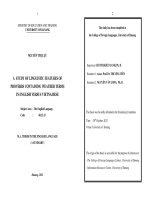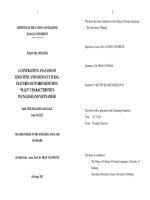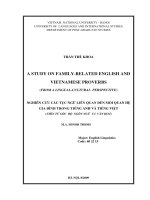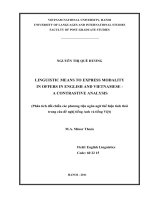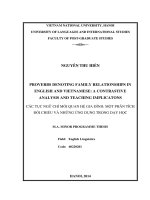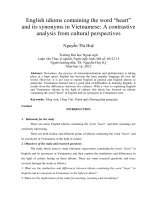proverbs denoting family relationships in english and vietnamese a contrastive analysis and teaching implications.” = các tục ngữ chỉ mối quan hệ gia đình một phân tích đối chiếu và những ứng dụng trong dạy họ
Bạn đang xem bản rút gọn của tài liệu. Xem và tải ngay bản đầy đủ của tài liệu tại đây (492.24 KB, 52 trang )
VIETNAM
N
N
A
A
T
T
I
I
O
O
N
N
A
A
L
L
U
U
N
N
I
I
V
V
E
E
R
R
S
S
I
I
T
T
Y
Y
,
,
H
H
A
A
N
N
O
O
I
I
U
U
N
N
I
I
V
V
E
E
R
R
S
S
I
I
T
T
Y
Y
O
O
F
F
L
L
A
A
N
N
G
G
U
U
A
A
G
G
E
E
S
S
A
A
N
N
D
D
I
I
N
N
T
T
E
E
R
R
N
N
A
A
T
T
I
I
O
O
N
N
A
A
L
L
S
S
T
T
U
U
D
D
I
I
E
E
S
S
F
F
A
A
C
C
U
U
L
L
T
T
Y
Y
O
O
F
F
P
P
O
O
S
S
T
T
-
-
G
G
R
R
A
A
D
D
U
U
A
A
T
T
E
E
S
S
T
T
U
U
D
D
I
I
E
E
S
S
N
N
G
G
U
U
Y
Y
Ễ
Ễ
N
N
T
T
H
H
U
U
H
H
I
I
Ề
Ề
N
N
PROVERBS DENOTING FAMILY RELATIONSHIPS IN
ENGLISH AND VIETNAMESE: A CONTRASTIVE
ANALYSIS AND TEACHING IMPLICATONS
CÁC TỤC NGỮ CHỈ MỐI QUAN HỆ GIA ĐÌNH: MỘT PHÂN TÍCH
ĐỐI CHIẾU VÀ NHỮNG ỨNG DỤNG TRONG DẠY HỌC
M.A. MINOR PROGRAMME THESIS
Field: English Linguistics
Code: 60220201
HANOI, 2014
VIETNAM
N
N
A
A
T
T
I
I
O
O
N
N
A
A
L
L
U
U
N
N
I
I
V
V
E
E
R
R
S
S
I
I
T
T
Y
Y
,
,
H
H
A
A
N
N
O
O
I
I
U
U
N
N
I
I
V
V
E
E
R
R
S
S
I
I
T
T
Y
Y
O
O
F
F
L
L
A
A
N
N
G
G
U
U
A
A
G
G
E
E
S
S
A
A
N
N
D
D
I
I
N
N
T
T
E
E
R
R
N
N
A
A
T
T
I
I
O
O
N
N
A
A
L
L
S
S
T
T
U
U
D
D
I
I
E
E
S
S
F
F
A
A
C
C
U
U
L
L
T
T
Y
Y
O
O
F
F
P
P
O
O
S
S
T
T
-
-
G
G
R
R
A
A
D
D
U
U
A
A
T
T
E
E
S
S
T
T
U
U
D
D
I
I
E
E
S
S
N
N
G
G
U
U
Y
Y
Ễ
Ễ
N
N
T
T
H
H
U
U
H
H
I
I
Ề
Ề
N
N
PROVERBS DENOTING FAMILY RELATIONSHIPS IN
ENGLISH AND VIETNAMESE: A CONTRASTIVE
ANALYSIS AND TEACHING IMPLICATONS
CÁC TỤC NGỮ CHỈ MỐI QUAN HỆ GIA ĐÌNH: MỘT PHÂN TÍCH
ĐỐI CHIẾU VÀ NHỮNG ỨNG DỤNG TRONG DẠY HỌC
M.A. MINOR PROGRAMME THESIS
Field: English Linguistics
Code: 60220201
Supervisor: Dr. Nguyễn Huy Kỷ
HANOI, 2014
i
DECLARATION OF AUTHOR
I certify that the minor thesis entitled Proverbs denoting family relationships in
English and Vietnamese: A contrastive analysis and teaching implications is
submitted in partial fulfillment of the requirements for the degree of Master of Arts
is the result of my own work, except where otherwise acknowledge and that this
minor thesis or any part of the same had not been submitted for a higher degree to
any other universities or institutions.
Hanoi, August 10
th
, 2014
Nguyễn Thu Hiền
ii
ACKNOWLEDGEMENTS
My study has been completed with the assistance and guidance of my teachers, my
friends and my relatives.
Firstly, I wish to express my deep thanks to my supervisor, Dr. Nguyễn Huy Kỷ, for
his valuable guidance, helpful suggestions and critical feedback on my study.
Secondly, I would like to give my gratitude to all my lecturers at the Faculty of
Post-Graduate Studies, University of Languages & International Studies, Vietnam
National University, Hanoi for their useful lectures which helped me a lot for
accomplishment of the study. In addition, my thanks also go to my friends from
class K21HP for their ideas, materials and enthusiasm.
Last but not least, I want to give my special thanks to my family, especially to my
husband, for their support and encouragement so that I could finish my study.
iii
ABSTRACT
Mieder [15: 11] states that the wisdom of proverbs has guided people in their social
interactions for thousand years throughout the world. They obviously contain a lot
of common sense, experience, wisdom and truth, and as such they represent ready-
made traditional strategies in oral speech acts and writings from high literature to
the mass media [15: 4]. Proverbs in general and proverbs denoting family
relationships in particular are useful for not only old people but also young ones.
They give us good pieces of advice and precious moral lessons. The study on
proverbs denoting family relationships in English and Vietnamese is an attempt to
investigate their syntactic features as well as their semantic ones. A contrastive
analysis has been made for the purpose of finding out the similarities and
differences between English proverbs denoting family relationships and Vietnamese
ones in terms of syntactic and semantic components. The result of the study may
make a great contribution to communication as well as writings. In addition, it may
also provide helpful suggestions for teachers and learners of English in using
proverbs. Through that, we can develop humanism which is really important and
indispensable in any society.
iv
TABLE OF CONTENTS
Page
Declaration i
Acknowledgements ii
Abstract iii
Table of contents iv
PART A: INTRODUCTION
1. Rationale 1
2. Objectives of the study 2
3. Research questions 2
4. Methods of the study 2
5. Significance of the study 3
6. Scope of the study 3
7. Organization of the study 3
PART B: DEVELOPMENT
CHAPTER 1: LITERATURE REVIEW
1.1. An overview of precious study 5
1.2. Theoretical background 6
1.2.1. Definition of proverbs 6
v
1.2.2. Definition of proverbs denoting family relationships 7
1.2.3. Definition of idioms 8
1.2.4. Proverbs and idioms 8
1.3. Summary 10
CHAPTER 2: METHODOLOGY
2.1. Restatement of the research questions 11
2.2. Data collection instruments 11
2.3. Procedures of data collection 12
2.4. Procedures of data analysis 12
2.5. Summary 13
CHAPTER 3: DATA ANALYSIS AND DISCUSSION
3.1. The syntactic features of English and Vietnamese proverbs denoting family
relationships 14
3.1.1. Conciseness 14
3.1.2. Symmetry 15
3.1.3. Sentential structures 16
3.1.4. Phrasal structures 21
3.2. The similarities and differences between English and Vietnamese proverbs
denoting family relationships in terms of syntactic features 22
3.2.1. Similarities 22
3.2.2. Differences 22
vi
3.3. Semantic features of English and Vietnamese proverbs denoting family
relationships 23
3.3.1. Meanings of proverbs denoting family relationships 23
3.3.2. Stylistic devices of English and Vietnamese denoting family
relationships 24
3.3.3. Semantic aspects of proverbs denoting family relationships in English
and Vietnamese 27
3.4. Semantic similarities and differences between the English and Vietnamese
proverbs denoting family relationships 31
3.4.1. Similarities 31
3.4.2. Differences 32
3.5. Summary 32
PART C: CONCLUSION
1. Recapitulation 34
2. Conclusions 35
3. Teaching implications 36
4. Limitations of the study 37
5. Suggestions for further study 37
REFERENCES 39
APPENDIX 1 I
APPENDIX 2 III
1
PART A: INTRODUCTION
1. Rationale
When learning a new language, everybody expects to study not only its words but
also its culture and customs as well. Sapir [22:1] insists that “every cultural pattern
and every single act of social behavior involves communication in either an explicit
or implicit sense”. The tool for this communication is language [13:1]. There are
many ways to approach a new culture. One of them is studying its proverbs and
sayings. Bank [3:1] claims that “Proverbs are condensed culture”. Furthermore,
Mieder [15:11] states that “The wisdom of proverbs has guided people in their
social interactions for thousand years throughout the world.” We can say, therefore,
proverbs are a very precious heritage of every nation, every ethnic group that should
be respected and preserved.
Vietnamese proverbs are not known for sure of the origin in term of their inception
and authors. They are orally transmitted and incessantly edited throughout
generations [10:5]. The content of Vietnamese proverbs are various, often reflect
human experiences about labor and production, about family and social
relationships in which proverbs denoting family relationships account for relatively
large numbers in Vietnamese folk songs store. Proverbs about the relationship
between husbands and wives, parents and children, brothers and sisters have been in
company with us during our whole lives. From the cradle, I was familiar with some
proverbs: “Chị ngã em nâng” [24:43], “Anh em như thể tay chân” [8:26] or “Một
giọt máu đào hơn ao nước lã” [18:276]. We were taught not only to love our
brothers and sisters but also to respect spiritual family sentiment. Furthermore,
some other proverbs gave us the lessons of respecting and being grateful to our
parents such as: “Công cha như núi Thái Sơn, nghĩa mẹ như nước trong nguồn chảy
ra” [18:274]. And there are still a lot of valuable proverbs which provide us with
many precious lessons in the treasure of Vietnamese proverbs. It is clear that family
proverbs have carved deeply into everyone’s mind. Therefore, they play an
2
important role in educating people to respect ancestors, history and traditional
cultures.
From the above reasons, I was attracted to study the thesis: Proverbs denoting
family relationships in English and Vietnamese: A contrastive analysis and some
teaching implications.
2. Objectives of the study
The objectives of the study are:
- to identify and analyze syntactic and semantic features of some proverbs denoting
family relationships in English and Vietnamese.
- to compare and contrast syntactic and semantic features of some proverbs
denoting family relationships in English and Vietnamese.
- to give some suggestions in teaching English and Vietnamese proverbs denoting
family relationships.
3. Research questions
Based on the above objectives, this study is going to give answers to the following
questions:
1. What are syntactic and semantic features of English and Vietnamese proverbs
denoting family relationships?
2. What are the similarities and differences in syntactic and semantic features of
English and Vietnamese proverbs denoting family relationships?
3. What are the implications of teaching English and Vietnamese proverbs denoting
family relationships?
4. Methods of the study
The research methods to be applied in this study include:
3
- quantitative and qualitative analysis which will be used for reading and
categorizing typical English and Vietnamese proverbs denoting family
relationships.
- comparative and contrastive analysis of proverbs in English and Vietnamese
which will be carried out in terms of syntactic and semantic features.
- synthesis analysis which will be used to synthesize the data and conclude the
similarities and differences between proverbs denoting family relationships in
English and Vietnamese.
5. Significance of the study
With the purpose of studying the syntactic and semantic features of proverbs
denoting family relationships in English and Vietnamese, the study will be able to
provide Vietnamese learners of English with better mastering of how to apply this
kind of proverbs in sensible ways, how to thoroughly understand, effectively and
naturally use them in receptive and productive skills.
6. Scope of the study
In this research, the author expects to find out, analyze and contrast syntactic and
semantic features of English and Vietnamese proverbs denoting family relationship.
The author will also make great efforts to discover the proverbs which have
contents related to the relationships of family members although they do not carry
family words. Contrastively, the proverbs which just carry family words do not
convey the contents of family relationships are not mentioned.
7. Organization of the study
The study consists of three main parts in addition to appendices and references.
Part A, introduction, introduces the rationale, the objectives, the research questions,
the methods, the significance, the scope and the organization of the study,
4
Part B is the development of the study which contains three chapters. The first
chapter focuses on an overview of literature review and theoretical background of
proverbs. Definition of idioms and the distinguishing between proverbs and idioms
are also mentioned in this chapter. The second chapter is methodology in which
data collection instruments, procedures of data collection, procedures of data
analysis are presented. The last chapter in part B is data analysis and discussion.
This chapter shows syntactic and semantic features of proverbs denoting family
relationships in English and Vietnamese. And then similarities and differences of
English and Vietnamese proverbs denoting family relationships in terms of syntax
and semantics will be concluded.
Part C is the conclusion of the study which includes the recapitulation of the
study as well as some conclusions, limitations, teaching implications and some
suggestions for further studies.
5
PART B: DEVELOPMENT
CHAPTER 1: LITERATURE REVIEW
The literature and the theoretical background on proverbs in both English and
Vietnamese are presented in this chapter. An overview of previous study which is
related to proverbs in English and Vietnamese as well as the definitions of proverbs
is presented. Then, the definitions of idioms and the distinguishing between
proverbs and idioms are also mentioned in this chapter.
1.1. An overview of previous study
Proverbs have attracted many scholars all over the world. There are some books
whose authors mentioned some aspects of proverbs. “Proverbs and their lessons”
written by Richard [21] presents an important survey of the origin, nature,
distribution, meaning and significance of proverbs in the English speaking world.
On the other hand, “American proverbs about women” by Kerschen [8] is an
examination of how women are treated by popular sayings that perpetuate folk
wisdom. Furthermore, “The fact on file dictionary of proverbs” by Martin [14]
provides full meanings of common proverbs arranged in the alphabetic order. The
book “Proverbs: A Handbook” by Mieder [15] is an inclusive and comparative
survey of paremiology and focuses on Anglo American proverbs in English
language context.
In Vietnam, many linguists have paid much attention to proverbs. Thu [24] and Lân
[9] shared the same ideas of classifying Vietnamese proverbs as every aspect of our
lives in two books “Ca dao, tục ngữ Việt Nam” and “Tục ngữ, ca dao Viêt Nam”
respectively. In addition, Lân [10] compiled a dictionary in which proverbs were
both literally and figuratively explained in the alphabetic order. Hùng [7] collected a
number of English proverbs and their Vietnamese equivalences which were helpful
for learners of English. Sa [22] focused on rhetorical simile between English
6
proverbs and Vietnamese ones. Finally, Phan [18] made a collection of proverbs
and folksongs in terms of content and classified them into many categories.
However, there have been few works relating proverbs denoting family
relationships particularly so far, to my knowledge. That is the reason why I attempt
to investigate the syntactic and semantic features of English and Vietnamese
proverbs denoting family relationships.
1.2. Theoretical background
1.2.1. Definitions of proverbs
There are many definitions of proverbs in both English and Vietnamese. In English,
according to Oxford dictionary [12], a proverb is a “well known phrase or sentence
that states the truth or gives advices”. On the other hand, Mieder [15: 3] defines “A
proverbs is a short, generally known sentence of the folk which contains wisdom,
truth, morals, and traditional views in a metaphorical, fixed and memorizable form
and which is handed down from generation to generation. Besides, Martin [14: 9]
shows that “A proverb is a saying usually short, that expresses a general truth about
life”.
Not only international scholars but also Vietnamese ones have paid more attention
to proverbs. Lân [10: 6] defines “Tục ngữ là những câu hoàn chỉnh, có ý nghĩa trọn
ven, nói lên hoặc một nhận xét về tâm lý, hoặc một lời phê bình, khen hay chê, hoặc
một câu khuyên nhủ, hoặc một kinh nghiệm về nhận thức tự nhiên hay xã hội…
Proverbs are complete sentences which carry full meanings, express spiritual
comments, criticisms, compliments or disparagements; or pieces of advice,
experiences about the nature or the society…. Phan [18: 27] states that: “Tục ngữ là
một câu tự nó diễn trọn vẹn một ý, một nhận xét, một kinh nghiệm, một luân lý, một
công lý, có khi là một sự phê phán.” A proverb is a sentence which expresses
complete meaning itself, a comment, an experience, a justice and a criticism as well.
Hùng [7: 10] claims that “Tục ngữ là câu ngắn gọn, thường có vần điệu, đúc kết tri
thức, kinh nghiệm sống và đạo đức thực tiễn của nhân dân.” A proverb is a short
7
sentence with rhythm and expresses people’s knowledge, life experiences and moral
principles.
As can be seen from the above definitions, there are different ways of defining a
proverb. In a short nut, the definition raised by Mieder is considered the most
appropriate to my study. A proverbs is a short, generally known sentence of the folk
which contains wisdom, truth, morals, and traditional views in a metaphorical, fixed
and memorizable form and which is handed down from generation to generation.
[15: 3]
1.2.2. Definition of proverbs denoting family relationships
In my opinion, family relationships are emotional connections between members in
a family in general. It consists of emotional connections between parents and
children, husbands and wives, siblings and other kinships. Proverbs which convey
the emotional connections are called proverbs denoting family relationships. They
are found in both forms of Vietnamese and English. For example, “Vợ chồng như
đũa có đôi” [24: 37]; “Anh em hòa thuận là nhà có phúc” [24: 43]; “Chị em dâu như
bầu nước lã” [17:44] are known as Vietnamese proverbs denoting family
relationships, and “As is the father, so is the son” [14:13]; “The family that prays
together stays together [14:85] as English ones.
1.2.3. Definition of idioms
According to Oxford dictionary [11], an idiom is a group of words in a fixed order
that have a particular meaning that is different from the meanings of each word on
its own. Furthermore, Michael and Felicity [16] stated that idioms are “expressions
which have a meaning that is not obvious from the individual words”. Like foreign
researchers, Phan [18] also states that an idiom is a part of a sentence and it cannot
express a complete idea itself. Lân [9] claims that idioms are fixed phrases to
express a concept.
8
1.2.4. Proverbs and idioms
When studying the proverbs, the researcher got much confused to distinguish
proverbs from idioms. So in this part, the differences between them will be pointed
in the hope of helping the readers have more knowledge of proverbs. Both idioms
and proverbs are fixed and available language units which are picturesque, highly
evocative and popularly used in communication. However, idioms differ from
proverbs in several ways. First, in terms of syntax, an idiom is a fixed phrase whose
meaning cannot be deduced from the meanings of its constituents while a proverb is
a complete sentence expressing one idea of comment, experience, morality, justice
or criticism. Let’s see some examples as follows:
(1) pull one’s weight [16: 42]
(2) An apple a day keeps the doctor away. [14]
It can be seen that example (1) is an idiom because it is a fixed phrase which does
not mean “put on one’s weight”. It means using a lot of energy and effort to do
something like in the sentence “If Sarah pulled her weight, she would easily be able
to complete her project on time.” However, example (2) is a proverb because it is a
complete sentence which contains a message. It is not just about the act of eating an
apple that can keep a doctor away. The message of the sentence is that we should
try to pursue a healthy diet to stay healthy.
Furthermore, an idiom can be a part of a proverb. This exists both in English and in
Vietnamese:
(3) Chồng yêu, xỏ chân lỗ mũi. [7: 13]
(4) Don’t put all your eggs in one basket. [7: 13]
We can see that “xỏ chân lỗ mũi” and “put all one’s eggs in one basket” are idioms
which belong to proverbs (3) and (4) respectively.
On the other hand, when studying the differences between proverbs and idioms,
Hùng [7] focused on their literature functions. According to his study, proverbs
carry three main literature functions: aesthetic function, perception function and
9
educational function whereas idioms bring only aesthetic function. Let’s consider
two examples for illustration below:
(5) Blood is thicker than water. [14: 30]
(6) get on like a house on fire [16: 52]
Example (5) concludes three literature functions. The perception function helps the
readers understand the loyalty and affection between members of the same family
are much stronger than any other relationship. Regarding educational function, it
educates people to have awareness of sacred family relationships and then
encourages them to live in harmony with family members. The methods of
exaggeration and symbolization used so as to attract the readers’ attention can be
understood as the function of aesthetics. Example (6) is an idiom expressing “get on
extremely well with someone”. It does not have the functions of perception as well
as education because it does not convey a comment, a piece of advice or a criticism.
It just owns the aesthetic function which is performed by using simile.
Let’s have a look at table 1 that summarizes the distinguishing criteria between
proverbs and idioms.
Features
Idioms
Proverbs
Structural realization
fixed phrases
usually complete sentences
Literature functions
aesthetic function
- aesthetic function
- perception function
- educational function
Expression
pure concepts
general truths, comments,
advices, experiences,
criticisms…
Table 1: Distinguishing criteria between proverbs and idioms
It is noteworthy that the boundaries we have proposed are fuzzy in the sense that
overlapping, to some extent, cannot be avoided. Although different units are
10
distinguished in the table, there are some exceptions that the boundary between
proverbs and idioms is sometimes vague. The unclear distinguishing between
proverbs and idioms can be found in Vietnamese more than in English. “Trong ấm
ngoài êm”, for example, may be understood to be both an idiom and a proverb. If it
is considered as a concept of inner and outer stableness, it will be an idiom. If
people think “trong ấm” will result in “ngoài êm”, it will be a proverb because it
shows the fact that the union and harmony inside will create a concrete base of good
relationships outside.
1.3 Summary
In chapter 1, the author has presented some previous studies about proverbs.
There are numerous studies of this subject but few studies refer to proverbs
denoting family relationships in English and Vietnamese. In addition, the definition
of proverbs and distinguish between proverbs and idioms have been mentioned. The
vague boundary between idioms and proverbs is also referred but the author does
not have a deeper research about it. In the next chapter, the author will deal with
methodology and procedures to carry out this study.
11
CHAPTER 2: METHODOLOGY
The methods of study are very important to find out the findings and conclusion of
the study. Therefore, the clearer methodology is given, the deeper the study is
understood. This chapter mainly aims at restating the research questions and
describing the procedures of collecting and analyzing data in the study.
2.1. Restatement of the research questions
This study is designed to analyze and describe syntactic and semantic features of
proverbs denoting family relationships in English and Vietnamese. The author made
use of contrastive analysis in qualitative and quantitative approaches to meet the
needs of the study. Data are collected, classified and analyzed both in English and
in Vietnamese to recognize the similarities and differences between English and
Vietnamese proverbs denoting family relationships. In other words, three following
research questions must be answered:
1. What are syntactic and semantic features of English and Vietnamese proverbs
denoting family relationships?
2. What are the similarities and differences in syntactic and semantic features of
English and Vietnamese proverbs denoting family relationships?
3. What are the implications of teaching and learning English and Vietnamese
proverbs denoting family relationships?
2.2. Data collection instruments
Most of the proverbs used in the study were collected from dictionaries, books,
articles, defended theses and researches. They are extremely famous works in
Vietnamese as well as in English. In Vietnamese, the author selected the data from
three main books: “Ca dao, tục ngữ Việt Nam” by Phương Thu [24], “Tục ngữ, ca
dao, dân ca Việt Nam” by Vũ Ngọc Phan [18] or “Tuyển tập thành ngữ, tục ngữ, ca
dao Việt – Anh thông dụng” by Nguyễn Đình Hùng [7]. In English, I mainly made
12
the reference of three important books: “Proverbs: A Handbook” by Wolfgang
Mieder [15], “The facts on file dictionary of proverbs” by Martin H. Manser [14]
and “The Penguin dictionary of proverbs” by Rosalind [20]. The materials are
chosen for several specific reasons. Firstly, it can be said that they are quiet popular
and currently available. Secondly, the scope of the materials is focused on common
proverbs especially proverbs denoting family relationships. And finally, the sources
of these data are believed to be reliable, suitable and adequate because they are all
published, submitted and related to the area of the study.
Besides the source of hard papers, the author also collected some proverbs from
internet. Then, the author checked them up again in dictionaries to ensure their
accuracy and reliability. Finally, I reached to some proverbs from the old people
and foreigners who are working with me at my center.
2.3. Procedures of data collection
In this present paper, the data are mainly obtained by observation and through
content-analysis. The data used for description and analysis in terms of structural
and semantic components are observed and taken out from reliable materials. By
that way, the author collected 100 proverbs denoting family relationships both in
English and in Vietnamese. Then the author carries out analyzing contents of the
proverbs to classify them into different categories such as proverbs denoting
relationships between parents and children, husbands and wives, siblings… in order
to make the study clearer. And this could help the readers easily understand the
content of the study. Moreover, the author asked some experienced people and
foreigners to get a couple of proverbs that were useful for the research.
2.4. Procedures of data analysis
After finishing the collection of data, the author carries out some research methods
to analyze the data so as to answer the research questions set up early in the study.
13
Firstly, contrastive analysis is used to estimate the differences in syntactic features
of English and Vietnamese proverbs. Each structure has at least one example for
illustration. By contrastive analysis, the author will discover the similarities and
differences in proverbs denoting family relationships in terms of syntactic features.
Secondly, the data will be analyzed qualitatively into semantic field. The data
collected are typical and representative for sematic characteristics of family
proverbs in English and Vietnamese. With the help of contrastive method, the
similarities and differences between them will be explored.
Finally, the author will draw some conclusions about proverbs in English and
Vietnamese due to carrying the methods of analyzing and synthesizing the data.
2.5. Summary
In the second chapter, the author would like to present the methodology of
the study. Data were collected from numerous sources such as dictionaries, books,
articles, websites… The proverbs were chosen and classified into different
categories so that the readers could follow the content easily. Description,
contrastive analysis and synthesis quantitatively and qualitatively were carried out
so as to find out the answers to the research questions.
14
CHAPTER 3: DATA ANALYSIS AND DISCUSSION
If the previous chapters have provided some knowledge background of proverbs in
general and the research methods of the study, this chapter will mention data
analysis and discussion. Firstly, it presents the syntactic and semantic features of
proverbs denting family relationships in both English and Vietnamese. And then the
similarities and differences of two countries’ proverbs will be concluded in terms of
syntax and semantics. The content of the chapter is summarized in the last section.
3.1. The syntactic features of English and Vietnamese proverbs denoting family
relationships
3.1.1. Conciseness
As defined by many linguists, one common but very important feature of proverbs
is the concrete structure. Vietnamese proverbs denoting family relationships are
usually in simple composition, being formed from four words to longer but they are
generally in short. Let’s see some proverbs which consist of four words as follows:
Máu chảy ruột mềm. [9: 22]
Khác máu tanh lòng. [9: 22]
Chị ngã em nâng. [24: 43]
Some are longer, however, ranging from eight to ten words.
Anh thuận em hòa là nhà có phúc. [24: 43]
Thuận vợ thuận chồng tát bể Đông cũng cạn. [23: 37]
Sảy cha còn chú, sảy mẹ ấp vú dì. [9: 22]
Sometimes, a few long proverbs consist of over ten words, making up of two
sentences. They account for few numbers and are close to folksongs such as:
Khôn ngoan đối đáp người ngoài,
Gà cùng một mẹ chớ hoài đá nhau. [10: 280]
As can be seen from the above examples, the meaning of the proverbs will be
changed if we add or take away just one word in the proverbs. In conclusion, there

